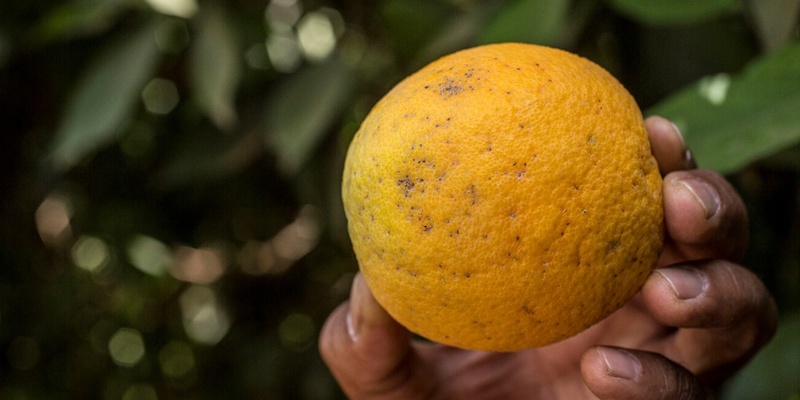Two new diagnostic protocols adopted to prevent harmful pests to crops
Posted on Thu, 30 Nov 2023, 11:18

© FAO - Oranges showing damages caused by the Ceratitis Capitata
Rome, 21 November 2023. The Standards Committee, on behalf of the Commission on Phytosanitary Measures (CPM), has adopted two diagnostic protocols that would help protect important crops from two particular plant pests, namely the fruit fly genus Ceratitis and the cassava green mite (Mononychellus tanajoa).
Diagnostic protocols – a set of procedures and methods for detecting and identifying regulated plant pests – are crucial in appropriately applying phytosanitary measures to facilitate safe international trade.
Diagnostic protocol 32: Genus Ceratitis
The genus Ceratitis, which is part of the family Tephritidae, commonly referred to as fruit flies, includes species that damage crops used for commercial and subsistence agriculture.
Once a female lays eggs into the fruit and the eggs hatch, the larvae feeds on the fruit and directly damages it. Indirect damage is caused by the increased susceptibility of the plant to opportunistic fruit pathogens resulting from injuries when the female lays eggs into the fruit as well as damages from larval feeding.
The Ceratitis species can feed on any fruit, but some are known to feed on a particular fruit or a lineage of plant species. However, the known relationship between many species of Ceratitis and their host plants is incomplete. In fact, some species may infest a wider range of hosts than currently reported.
Diagnostic protocol 32 includes six economically important Ceratitis species based on their distribution and status as polyphagous pests or those feeding on multiple plant species.
The most destructive species in the genus is the Mediterranean fruit fly (Ceratitis capitata), native to sub-Saharan Africa but has successfully spread to other regions of Africa as well as in Hawaii, South America, Central America, Australia and countries in the Mediterranean region. Hundreds of plant species have been reported as hosts of the Mediterranean fruit fly.
Meanwhile, the mango fruit fly (C. (Ceratalaspis) cosyra (Walker)) is a pest of many fruit hosts apart from mango, including soursop, loquat, each and guava. It is found throughout much of sub-Saharan Africa and is reported to be a cryptic species complex.
The other four species included in the protocol are C. (Pterandrus) fasciventris (Bezzi), C. (Pterandrus) anonae Graham, C. (Pterandrus) rosa Karsch and C. (Pterandrus) quilicii De Meyer et al. They infest a wide range of commercially grown hosts. The distribution for each of these four species includes multiple countries across sub-Saharan Africa. Although each species has a different distribution range, these ranges can overlap.
Diagnostic protocol 33: Mononychellus tanajoa
The cassava green mite (Mononychellus tanajoa) is one of the major pests of cassava, a staple crop for more than 11 percent of the world’s population. It is a tropical and subtropical species and is now widely distributed in Africa and South and Central America.
The cassava green mite feeds by piercing plant tissues and sucking out the contents of cells, leading to leaf distortion and chlorotic mottling, defoliation of the upper parts of shoots, leading to a 50–80 percent storage-root yield loss.
Diagnostic protocols are the result of an average four-year process: international diagnostic experts draft the protocols and are then reviewed by the Technical Panel on Diagnostic Protocols (TPDP), a group of international experts nominated by the Standards Committee (SC). They are then submitted for international consultation, reviewed and adopted by the SC. This lengthy process ensures that such protocols are harmonized for all contracting parties to the International Plant Protection Convention (IPPC) to apply in the international trade of crops. Contracting parties are notified of newly adopted diagnostic protocols, with the IPPC Secretariat opening the notification period twice a year.
“It is known that early detection and accurate diagnosis can minimize the risk and impact of a pest outbreak. These new adopted international diagnostic protocols will add to the suite of diagnosis option to all IPPC contracting parties, enhancing their capacities on harmonized information and pest diagnostic methods,” said Adriana G. Moreira, IPPC Standard Setting Officer of the IPPC Secretariat.
The newly adopted diagnostic protocols are available at the Adopted Standards (ISPMs) webpage at: https://www.ippc.int/en/core-activities/standards-setting/ispms/.
For more information on the diagnostic protocols notification period, please visit https://www.ippc.int/en/core-activities/standards-setting/notification-period-dps/

